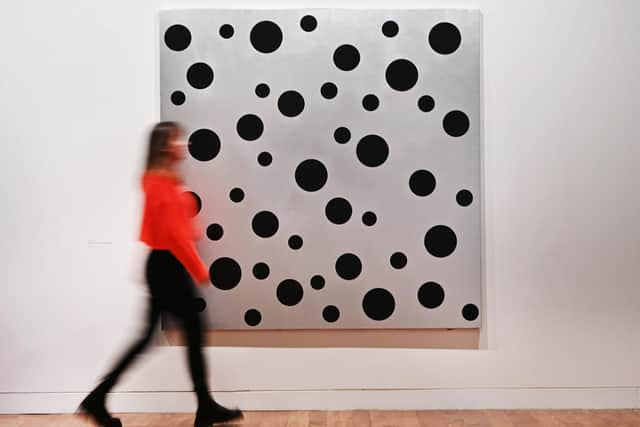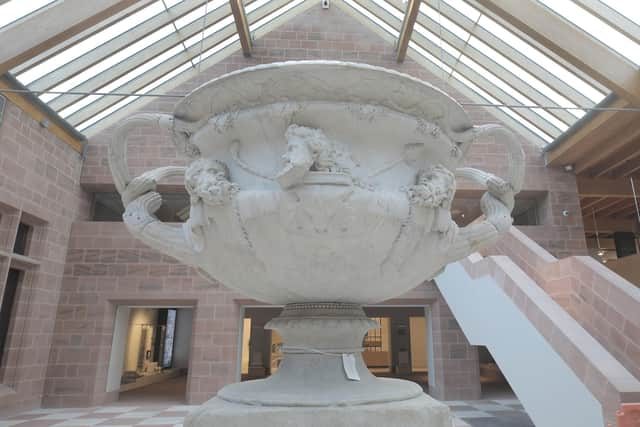Arts review of 2022: Susan Mansfield and Duncan Macmillan on the year in visual art
Flesh Arranges Itself Differently, Hunterian Art Gallery, Glasgow This stimulating group show about the body and the self sprang from the meeting of two collections: the Hunterian Museum, with its wealth of material relating to medicine and anatomy, and the international collection of contemporary art held by the Roberts Art Institute (formerly the David Roberts Art Foundation). Thus anatomical watercolours by Glasgow Boy Robert Macaulay Stevenson, made while an art student in the 1870s, hung next to the work of contemporary Swiss artist Miriam Cahn and Kenya-born Michael Armitage. Nothing in the show was predictable with Scotland-based artists Christine Borland and Ilana Halperin included alongside Rita Ackermann, Robert Rauschenberg and German outsider artist Horst Ademeit. It was a great example of how a themed show can explode in a hundred different directions. – SM
Michael Clark: Cosmic Dancer, V&A Dundee This celebration of the “bad boy of ballet” pulsated with loud music and moving image, relying comparatively little on static exhibits, apart from a few pieces of costume and set. Clark, born in Aberdeenshire, turned the ballet world upside down in the 1980s with his prodigious talent and subversive energy, starting his own dance company at the age of 22, choreographing to The Fall and David Bowie with costumes by Leigh Bowery and BodyMap. Florence Ostende’s show illuminated his work as a riposte to the conformity and conservative values of Thatcher’s Britain, celebrating queer culture and taking on issues as diverse as homophobia, police brutality and sectarianism in a punkish mash-up of pop art and postmodernism. – SM
Advertisement
Hide AdThe Burrell Collection reopening, Glasgow Much fanfare heralded the long awaited reopening of Glasgow’s Burrell Collection in March 2022 after a £68million refurbishment, putting more of Sir William Burrell’s multifarious haul on show than ever before in a repaired and remodelled building. While not without quibbles (for me, the main paintings gallery and some of the labelling) the new Burrell is a delight, bringing together under one roof ancient artefacts, porcelain, carpets, stained glass, chunks of medieval buildings, suits of armour, sculpture by Rodin and paintings by Rembrandt and Degas. The curators have tried to impose order on it with some themed galleries, but happily the collection retains its “magical mystery tour” quality revealing something extraordinary every time you turn a corner, and something new on every visit. – SM


Masterpieces from Buckingham Palace, Queen's Gallery, Edinburgh In 2022, before we mourned the late Queen, we celebrated her jubilee. This was the occasion for one of the truly outstanding exhibitions of the year. Called Masterpieces from Buckingham Palace, for once this was not just hype. They really were masterpieces, and all from the 17th century. One of the stars was Cristofano Allori’s Judith with the Head of Holofernes. Holofernes’s severed head is the artist’s self-portrait, Judith the portrait of a lover who jilted him. Artemesia Gentileschi’s self-portrait was even more memorable, but then there were two paintings by Rembrandt, including his hypnotic portrait of Agatha Bas. There was a beautiful view of Rome from Tivoli by Claude and a wonderful sunlit courtyard scene by Pieter de Hooch. There was much more too, but it was especially wonderful to see here in Scotland one of Teniers’s inimitable scenes of rustic revelry. It is an image that echoed through the poetry of Fergusson and Burns and later through Scottish painting. – DM
Will Maclean: Points of Departure, City Art Centre, Edinburgh This beautifully laid out retrospective of Will Maclean’s work was planned to mark the artist’s 80th birthday, but because of circumstances it marked his 82nd. It was nevertheless a wonderful survey of a remarkable body of work. Assemblage is Maclean’s principal medium, although that term does not do justice to the refinement of the way he works, assembling things certainly, but adding to them things he’s made, writing and all sorts other visual references. Together it creates a physical metaphor for the poetic imagination and, through it, his imagination reflects on the explorers, mariners and emigrants who braved the northern seas and on the Highland story. He is, however, also a master draughtsman and printmaker. One of his outstanding achievements is the series of beautiful etchings, A Night of Islands, reflecting on writings of the Gaelic poets. It is in its way a monument as much as the grand monuments of stone and bronze illustrated in the show that he has, with others, created on the Isle of Lewis to commemorate the people of the island who fought back against the Clearances. – DM
A Taste for French Art: Modern French Art from Millet to Matisse, Scottish National Gallery, Edinburgh This did not claim to be an exhibition of masterpieces like the show in the Queen’s Gallery and had it done so it would have been unjustified hyperbole. There were masterpieces on show, certainly. Gauguin’s Vision after the Sermon and Three Tahitians, Cézanne’s Mont St Victoire and The Big Trees, Monet’s Haystacks, Snow Effect and Degas Little Dancer really are masterpieces by any reckoning, but this was a display of the whole of the national collection of French art from the age of impressionism, the mid-19th century to the early 20th. The selection also included work by painters like Corot and Daubigny, however, precursors of Impressionism, and by Matisse who came long after its heyday. It was fascinating to see the whole thing set out like this and how, even though not everything is first-class, there is much that really is and perhaps the collection is richer for its variety. What did also come across is how much we are indebted to Stanley Cursiter, gallery director from 1930 to 1948, who was responsible directly or indirectly for the acquisition of most of the real masterpieces here. – DM
Claude Cahun: Beneath the Mask, Gracefield Arts Centre, Dumfries This was a chance discovery on a rainy day in Dumfries, a revelatory show about a remarkable woman working 100 years ago. Born Lucy Schwab in 1894, Cahun adopted a gender neutral name in 1917 and worked with the surrealists in Paris in the 1920s and 1930s. Her medium was photography, her most important tool her own body, whether using costumes and disguises a la Cindy Sherman, half-disappearing into furniture like Francesa Woodman, or making abstract shapes for a camera directly overhead. In 1938, she fled France for the Channel Islands where she and her partner Suzanne Malherbe (who also took a gender neutral name, Marcel Moore) were active in the Resistance. New prints created from her negatives by Hayward Touring presented work which looked both fresh and timely, nearly 70 years after her death. – SM


The Afterlife of Mary Queen of Scots, Hunterian Art Gallery, Glasgow Mary Queen Scots has had a very mixed press. In her lifetime, in the eyes her Protestant enemies she was a licentious, possibly murderous, diabolical Catholic, while to her Catholic supporters she was their white hope and eventually martyr for their cause. The Afterlife of Mary Queen of Scots at the Hunterian Art Gallery sought to throw some light on what her true story was and how it later passed from history to romance. To do this, the show brought together a remarkable body of evidence drawing extensively on Glasgow University and the Hunterian’s own collections. These include amazing coins and medals, and those from Mary’s reign provided some of the most telling testimony here. Her portrait on a coin of 1561, for instance, shows a handsome and determined looking woman and she must indeed have been remarkable to hold her own for as long as she did against the Protestant misogynists with whom she had to deal. Murdered by her cousin Elizabeth of England, she passed into history, for one side at least as a beautiful martyr, but then morphed from that into the familiar figure of tragic romance. – DM
Advertisement
Hide AdMark Cousins: Like A Huge Scotland, Fruitmarket Gallery, Edinburgh What happens when an artist has an epiphany? For example, when Wilhelmina Barns-Graham went to the Grindelwald Glacier in 1949 and experienced something which changed the way she painted for the rest of her long life? Filmmaker Mark Cousins tried to get under the skin of this moment in this four-screen installation with an eight-channel soundscape. Shown for just a month in the Fruitmarket’s warehouse space, it is a moving reflection on time, ageing and the nature of artistic inspiration, while never quite explaining the mystery. A spare, insightful text takes the form of a dialogue between the younger Barns-Graham and the artist 50 years on. “Describe it!” the younger woman asks the older, about the glacier moment. “I have,” she replies, “in my paintings.” – SM
Glean, City Art Centre, Edinburgh Throughout 2022 the Edinburgh City Art Centre continued to provide the most diverse and original exhibition programme of any Scottish institution, but towards the end of the year one small gem in particular stood out. Still ongoing, Glean brings together the work of eight pioneering women photographers and film-makers who were either Scottish or who worked in Scotland in the first part of the last century. The pictures of the Highlands and Islands are especially memorable. Johanna Kissling took photos of the people of St Kilda in 1905. Isabell Burton MacKenzie documented life in the Western Isles before the First World War while Dr Beatrice Garvie photographed her community when she was a doctor on North Ronaldsay in the 1930s and ’40s. The American folk-song collector, Margaret Fay Shaw, photographed her companions living on South Uist and Jenny Gilbertson filmed A Crofter’s Life on Shetland in 1931. These are all remarkable documents, but not all the photographs are of Scotland. Christina Broom’s photos of the Women’s Marches in London in 1909 and 1911 are truly stunning icons of the early history of the women’s movement. – DM